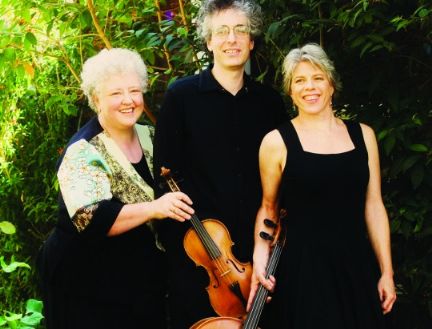|
Symphony
MONUMENTAL MAHLER 5TH IN SO CO PHIL'S SEASON ENDING CONCERT
by Terry McNeill
Sunday, April 14, 2024
Chamber
OAKMONT SEASON CLOSES WITH STRAUSS' PASSIONATE SONATA
by Terry McNeill
Thursday, April 11, 2024
Chamber
MORE GOLD THAN KORN AT ALEXANDER SQ CONCERT
by Terry McNeill
Sunday, April 7, 2024
Choral and Vocal
VIBRANT GOOD FRIDAY REQUIEM AT CHURCH OF THE ROSES
by Pamela Hicks Gailey
Friday, March 29, 2024
TWO OLD, TWO NEW AT THE SR SYMPHONY'S MARCH CONCERT IN WEILL
by Peter Lert
Saturday, March 23, 2024
Chamber
NOT A SEVENTH BUT A FIRST AT SPRING LAKE VILLAGE CONCERT
by Terry McNeill
Wednesday, March 20, 2024
THIRTY-THREE PLUS VARIATIONS AND AN OCEAN VIEW
by Terry McNeill
Saturday, March 16, 2024
Choral and Vocal
A ST. JOHN PASSION FOR THE AGES
by Abby Wasserman
Friday, March 8, 2024
Choral and Vocal
SPLENDID SCHUBERT SONGS IN SANET ALLEN RECITAL
by Terry McNeill
Saturday, March 2, 2024
Chamber
SHAW'S MICROFICTIONS HIGHLIGHTS MIRO QUARTET'S SEBASTOPOL CONCERT
by Peter Lert
Friday, March 1, 2024
|
 |
 Monica Huggett, Eric Zivian, Tanya Tomkins |
SCHUMANN'S INTIMATE CONVERSATIONS IN SCHROEDER
by Sonia Morse Tubridy
Saturday, January 30, 2016
An ensemble of five outstanding musicians from Valley of the Moon Music Festival presented Jan. 30 a program "Schumann The Intimate Conversationalist" program to a rapt and delighted audience in Schroeder Hall.
On entering the hall there was on stage the sight of an exquisite Viennese fortepiano built in 1841. This instrument differs from a modern piano in many ways, including very little metal in its construction. The action and tone are lighter and the result is an instrument that blends wonderfully with string instruments. Cellist Tanya Tomkins and violist Jodi Levitz conversed with each other and the audience before the musical presentation, and they stated that Schumann wrote “music for the piano looms large" and "first radiance of new genius is found at the keyboard.” They explained that the three pieces on the program: Kinderszenen (1838), Trio in G Minor (1847) and Quintet, Opus 44 (1842) were written within ten years of the building of this piano and that this concert represented three aspects of Schumann's manifold compositional style.
Kinderszenen (Scenes of Childhood), a much beloved set of thirteen miniature poetic character pieces, were performed by pianist Eric Zivian. He played with fine expressiveness and intelligence, shaping each piece with subtle dynamics and great clarity. The gentle lyrical tone of this instrument that does not rely on power intensified the performance, the intimate conversation between composer and pianist reaching out to engaged listeners.
Ms.Tomkins and violinist Monica Huggett joined Mr. Zivian for the G Minor Trio. The violin and cello used gut strings and all instruments blended well with little vibrato use. This Trio heralds new compositional styles heading towards the 20th century with a spontaneous improvisatory feel replacing organized development of ideas. The first movement introduced an unusual trio sound in which the individual contrasting colors of the parts available with modern instruments were replaced by a communal blended sound based on the ideal in early music ensembles. One striking change was the subdued role of the piano in the ensemble, sometimes actually covered by the violin and cello. In this movement, surges of upward waves of sound in the piano supported passionate outbursts and singing string lines. The sound seems to emerge from a deep emotional place, almost diabolical at times, and with many small surprising gestures.
The second movement is a unique love duet filled with almost unbearable longing, the piano adding touches of bright highlights and filling in emotional moments in this conversation. A middle section was reminiscent of ominous realities before returning to the poignant love duet, ending with a musical sigh. Clara Schumann is said to have especially loved this trio and this afternoon’s performers were deeply engaged.
The short third movement features harmonically strange piano passages with the many long pedal markings working well on the fortepiano. A wild joyful tarantella balances the spooky outer sections which lead to the fourth movement marked Kraftig mit (humor). This last movement has a bit of everything: foot stomping folk vigor, lyrical cello passages turning the music sentimental, a vibrant march section and more. New ideas emerge and then disappear into familiar themes with new variations. The trio ends with bright optimism and the audience applauded enthusiastically.
After an intermission the musicians returned with violinist Carla Moore and Ms.Levitz for the Quintet in E Flat, one of the greatest in this genre. It took some adjusting to the lighter sound of this ensemble, in which the grand piano sounds usually heard were often in the background. The joy and exuberance of the first movement's opening were interrupted by contemplative and thoughtful piano statements with delightful amounts of rubato. There were the beloved cello/viola duos and a new take on the dark development section with strong string chords leading and piano passages a background rumble.
The second movement with it's solemn, staggering march led through different moods to the wild and furious episode in which an astonishingly intense viola rendition of the main theme leads back to quiet and peace. The Scherzo was taken at a breathtaking tempo with exuberance and power in which the viola part was once again an exciting driving force. The last movement was a demonstration of the new kind of beauty to be heard when the piano is not the main part but often a quiet and more bell-like presence. There was much charm in the trading of melodies and the brisk tempo gave great broad gestures to this grand finale.
Applause was plentiful for this fresh, enlightening and moving experience of Schumann's genius and humanity.
Nicki Bell contributed to this review.
|

